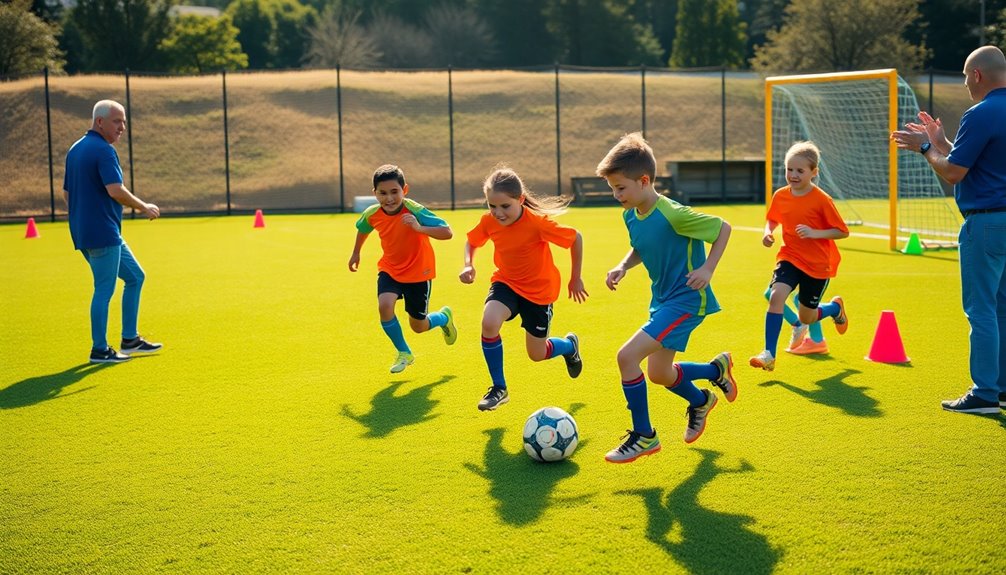
Small Sided Soccer Games That Make Practice More Engaging
February 6, 2025Small-sided soccer games can make your practice lively and engaging. Formats like 3v3 or 4v4 encourage creativity and quick decision-making, allowing players to experiment with skills and tactics. These games foster teamwork while keeping everyone involved, ensuring more ball touches and active participation. By integrating dynamic drills focused on dribbling, passing, and shooting, you enhance players' technical abilities and game intelligence. Switching roles during these games cultivates versatility and understanding of different positions. Dive deeper, and you'll discover various strategies to elevate your team's engagement even further.
Benefits of Small-Sided Games
When you engage in small-sided soccer games, you'll notice a significant boost in player engagement and skill development. These formats increase the number of touches on the ball for each player, making practice sessions not only more enjoyable but also more effective. This increased frequency of touches helps players develop fundamental skills that are essential in competitive play.
You'll find that the higher intensity and continuous movement required in these shorter games enhance your physical fitness, pushing you to improve your endurance and agility. Additionally, the need for quick decision-making during these games reinforces the principle of collective decisions, which is crucial for effective teamwork.
Moreover, small-sided games foster better communication and teamwork. With fewer players on the field, you'll learn to work closely with your teammates, developing stronger connections and collaborative strategies.
Coaches can easily assess individual performance, providing targeted feedback that helps you refine your skills.
In these less pressured environments, you're encouraged to pursue tactical experimentation. You can safely explore new strategies and improve your decision-making skills under dynamic conditions. Teamwork enhancement exercises such as the 4-on-4 Touch the Line drill can further improve your collaborative efforts during these games.
This freedom allows you to grow as a player, both individually and as part of a team. Ultimately, small-sided games create a rich learning atmosphere where engagement, skill development, and teamwork thrive.
Types of Small-Sided Games
Small-sided games come in various formats, each offering unique benefits that cater to different aspects of player development. The 3v3 and 4v4 formats are fantastic for promoting creativity and quick thinking. They give players more touches on the ball, enhancing their decision-making skills under pressure.
If you're looking to develop positional awareness, 5v5 games encourage players to navigate a larger area while maintaining team dynamics and communication.
Rondos are another effective small-sided game, focusing on ball retention and passing under pressure. These exercises help players refine their technical skills and improve spatial awareness through competitive scenarios.
For a more engaging experience, consider organizing small-sided tournaments. They foster a competitive spirit, boosting player engagement while making practice sessions enjoyable.
You can also incorporate variations with small goals to emphasize shooting accuracy and goalkeeping skills. This encourages players to focus on precision in a dynamic game environment. Additionally, incorporating communication on the field can enhance teamwork and improve passing execution during these games.
Essential Drills for Development
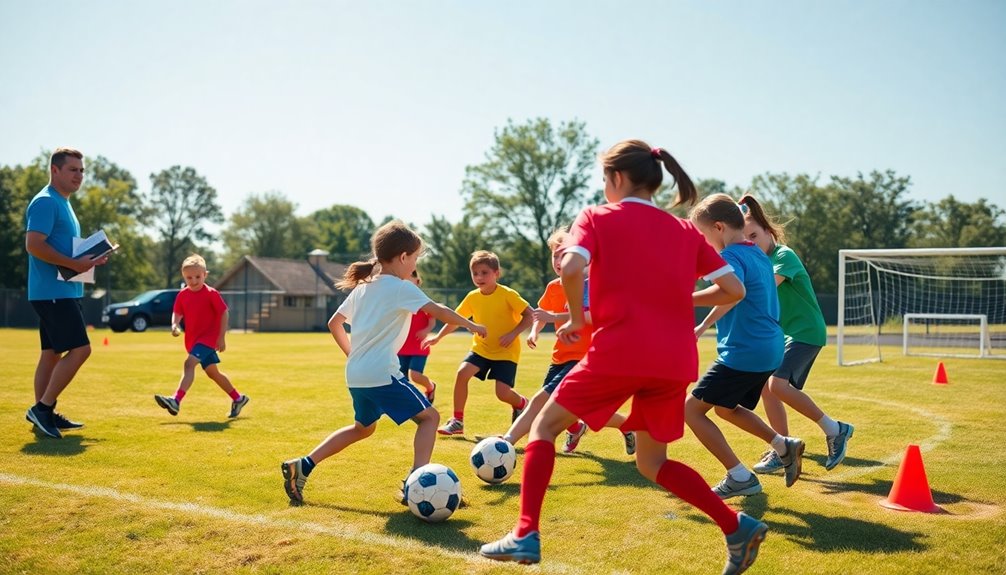
To develop essential skills for small-sided soccer games, you'll want to focus on targeted drills that enhance various aspects of gameplay.
Start with dribbling drills to improve ball control and agility, allowing you to navigate through defenders more effectively. These skills are fundamental in tight spaces typical of small-sided games, and mastering basic soccer moves will further enhance your dribbling capabilities.
Next, incorporate passing drills that emphasize accuracy and timing. Maintaining possession and creating scoring opportunities depends on these skills.
Shooting drills are also important; they focus on technique and placement, helping you finish chances during matches.
Don't overlook defensive drills, which teach positioning and tackling. These aspects are vital for maintaining team shape and disrupting opponents' attacks.
Finally, combination play drills will enhance teamwork and movement off the ball, fostering better interchanges and fluidity during matches. Additionally, implementing consistent practice is crucial for refining these skills and ensuring continuous improvement in your gameplay.
Coaching Strategies for Engagement
Engaging players during small-sided games requires clear objectives that keep everyone focused and aligned with developmental goals. To enhance player engagement, consider these coaching strategies:
- Set Clear Objectives: Define specific goals for each small-sided game to maintain player focus and guarantee alignment with overall developmental targets.
- Encourage Tactical Flexibility: Use varied formations during games, teaching players to adapt their play style in different scenarios and promoting tactical flexibility.
- Provide Constructive Feedback: Offer immediate, constructive feedback during and after games to promote player growth and reinforce learning points effectively.
- Promote Calculated Risks: Encourage players to take calculated risks in their play, fostering an environment where experimentation is valued, and mistakes are viewed as learning opportunities.
Creating a positive atmosphere during practice sessions is essential. Coaches who utilize engaging resources and drills often report feeling more inspired. Additionally, understanding specific roles within their positions can help players execute strategies more effectively during these games.
When players feel supported and encouraged, their focus sharpens, leading to greater engagement in small-sided games. By implementing these strategies, you'll cultivate an environment conducive to player growth, guaranteeing that your practice sessions aren't only productive but also enjoyable.
Game Setup and Mechanics
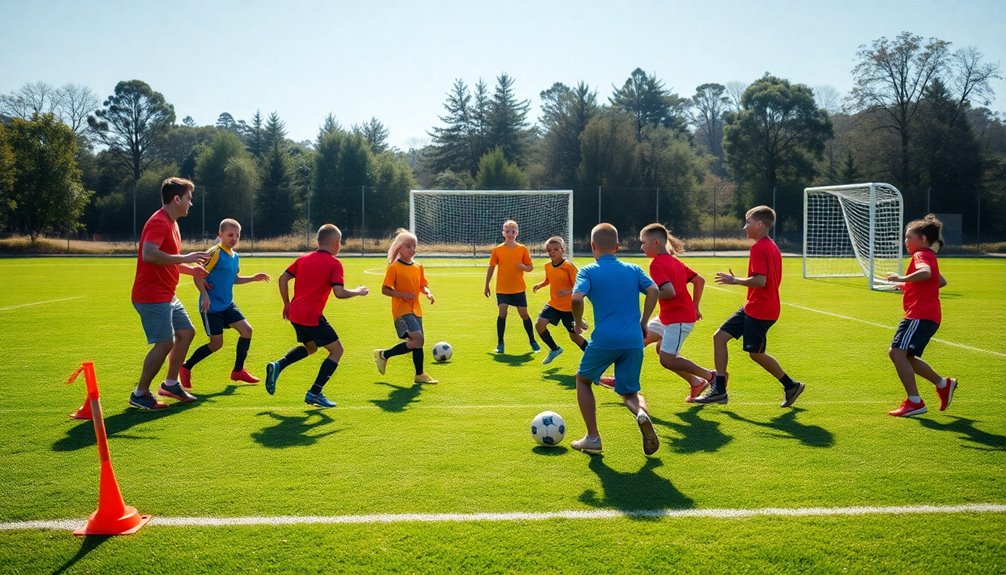
When setting up small sided games, you'll want to take into account the field size and dimensions that best suit your players' age and skill levels. Team composition is essential, as having the right mix of players helps everyone understand their roles and responsibilities on the field. Incorporating effective player selection is crucial for maintaining balance in formations during these games. Understanding the importance of team composition can enhance the overall performance and enjoyment of the game. Additionally, fostering effective communication among players can significantly improve their ability to work together and execute strategies during practice.
Field Size and Dimensions
Field dimensions play an essential role in the setup and mechanics of small-sided soccer games, directly impacting player engagement and skill development. The right field size can enhance players' spatial awareness and improve their overall game experience.
Here are four key considerations for field dimensions:
- Playing Area: Adjust the size based on player age and ability—20×30 meters for 3v3 games and up to 40×60 meters for 5v5 formats.
- Penalty Box: Utilizing a penalty box setup maximizes width, encouraging players to utilize the entire field effectively.
- Player Engagement: Verify an appropriate number of players per format; 6-8 players for a 3v3 game verifies sufficient ball touches and engagement.
- Shooting Accuracy: Use small goals at each end to emphasize shooting accuracy and enhance goalkeeping skills, making each game more dynamic.
Team Composition and Roles
Understanding team composition and roles in small-sided soccer games can considerably enhance the overall experience for players. In these formats, you typically see varying player numbers like 3v3, 4v4, or 5v5. This setup promotes individual skill development and fosters teamwork, making practice sessions more engaging.
Each player often takes on multiple roles, which encourages adaptability and helps you grasp different positions and responsibilities on the field. The defined play area can be adjusted based on age and ability, ensuring that everyone remains involved and maximizes touches on the ball.
Small-sided games emphasize movement off the ball, urging you to create space and exploit gaps in the opposition's defense. This focus enhances your tactical awareness, making you a more versatile player.
Coaches can implement specific gameplay mechanics, such as limiting touches or introducing designated goals for scoring. These strategies not only motivate you but also sharpen your strategic thinking during practice.
Integrating Games Into Training
Integrating small-sided games into your training sessions can greatly elevate player engagement and skill development. These formats, like 3v3 or 4v4, allow players to get more touches on the ball and make quick decisions in a less pressured environment.
Here are some key benefits:
- Enhanced Skills: Small-sided games serve as an excellent warm-up, reinforcing skills while keeping players active and focused. Additionally, incorporating speed and agility development into these games further enhances player responsiveness on the field. This dynamic approach mirrors structured speed running sessions, maximizing conditioning while keeping players engaged.
- Dynamic Drills: Scheduling small-sided matches after structured drills keeps your sessions lively and enjoyable.
- Individual Assessment: Coaches can assess individual performance more effectively during these games, providing targeted feedback based on observed strengths and weaknesses.
- Versatility Development: Rotating players through different positions encourages adaptability, helping them understand various roles and responsibilities on the field.
Additionally, incorporating advanced skills like the Elastico and Rainbow Flick can further engage players and enhance their technical repertoire.
Enhancing Player Decision-Making
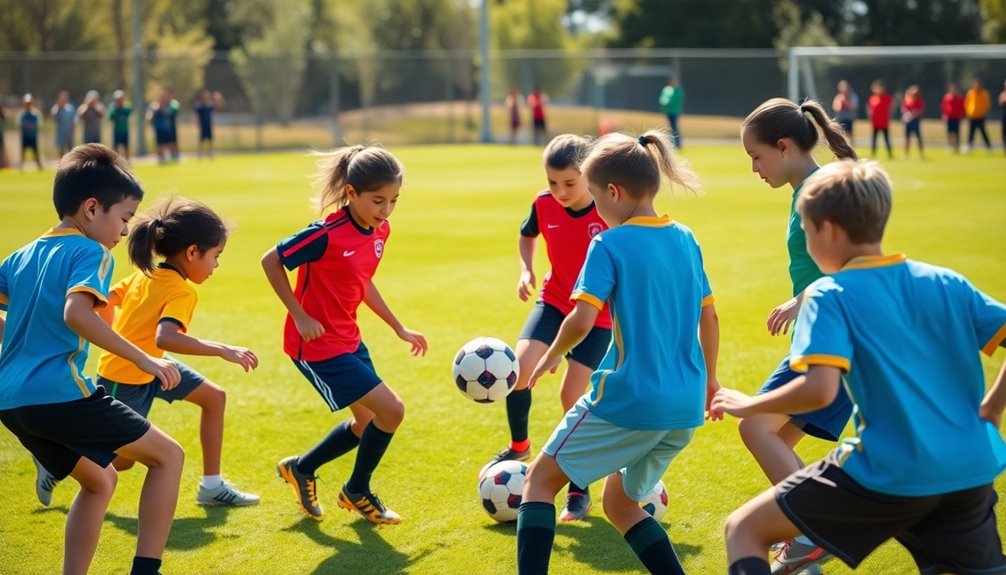
When you engage in small-sided games, you boost your situational awareness and quick decision-making skills. These formats force you to evaluate tactical options rapidly, helping you become more adaptable on the field. Additionally, practicing defensive techniques during these games enhances your ability to apply pressure and intercept passes effectively. Incorporating transition and recovery drills into these games further sharpens your ability to shift quickly between attacking and defending roles.
Situational Awareness Development
In small-sided soccer games, players quickly learn to scan their environment, which sharpens their situational awareness and enhances decision-making on the field.
This dynamic format allows you to make around 20% more choices per minute compared to traditional matches, providing valuable practice for real-game scenarios.
Here are four key benefits of developing situational awareness through small-sided games:
- Enhanced Scanning Techniques: Regular drills like "Scan When You Can" improve your ability to anticipate opponents' movements.
- Improved Passing Options: With heightened awareness, you can identify and utilize passing options more effectively.
- Space and Positioning Awareness: You'll learn to exploit gaps in the defense, increasing your scoring opportunities by up to 30%.
- Continuous Feedback: Coaches provide ongoing insights during activities, helping you refine your decision-making and boosting players' accuracy by an average of 15% over a season.
Quick Decision-Making Drills
Quick decision-making drills are essential for developing a player's ability to react swiftly and effectively during matches. Incorporating small-sided games, like 3v3 or 4v4, creates high-pressure scenarios that demand quick decision-making, enhancing both your tactical awareness and situational awareness.
These practice drills simulate match conditions, allowing you to develop the skills needed to perform under pressure. Engaging in these drills not only sharpens your decision-making but also fosters creativity and adaptability.
As you navigate the small playing area, you'll frequently assess your surroundings and make split-second choices to exploit available space. The game format of "Tag" is a great example; it combines fun with skill development, pushing you to enhance your decision-making while dribbling and avoiding defenders.
Regular participation in small-sided games leads to better performance in actual game situations. The more you practice quick decision-making, the more instinctively you'll respond during matches.
Tactical Options Exploration
Building on the skills honed through quick decision-making drills, exploring tactical options in small-sided games elevates your gameplay even further. These formats create a dynamic environment where you can refine key aspects of your game:
- Spatial Awareness: Enhance your ability to read the field and understand positioning.
- Movement Off the Ball: Develop strategic movement to create space and scoring opportunities.
- Ball Retention: Focus on maintaining possession through effective passing and decision-making.
- Game Intelligence: Learn to adapt quickly to changing situations, improving your overall tactical acumen.
In small-sided games, the reduced number of players means you'll enjoy more touches on the ball, allowing for frequent decision-making opportunities. As you navigate these scenarios, you'll find that evaluating tactical options becomes second nature.
Incorporating variations like rondos emphasizes quick passing and ball retention, which are essential for choosing effective passing angles. Ultimately, by engaging in this tactical exploration, you'll boost your practice engagement and develop the skills necessary to excel in real match situations.
Embrace these challenges, and watch your game intelligence and decision-making flourish on the field.
Creating a Positive Atmosphere
A coach's role in creating a positive atmosphere during small-sided soccer games can't be overstated. When you prioritize enjoyment, you enhance player engagement, allowing your athletes to feel confident and enthusiastic to participate.
Research shows that 89% of users report increased confidence when they train in a fun environment. This supportive setting encourages players to experiment with their skills and tactics, fostering creativity and honing their decision-making under pressure.
Regular feedback and constructive communication during these games promote teamwork and growth, making players feel valued and understood.
By incorporating varied game formats and challenges, you keep your practices dynamic and interesting, which leads to improved participation and enjoyment levels. Coaches who focus on creating a positive atmosphere often see better retention and development in their players; in fact, 93% of coaches feel more inspired after using engaging materials and methods.
In essence, cultivating an atmosphere that encourages creativity, feedback, and teamwork not only makes practices more enjoyable but also lays the foundation for long-term player development and success.
Community Support for Coaches
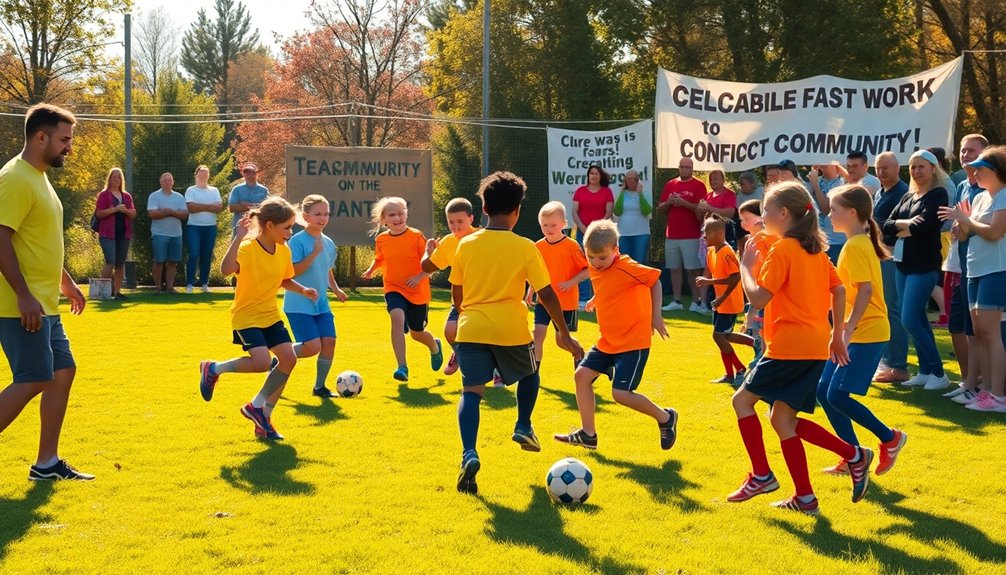
In today's competitive soccer landscape, community support plays a crucial role in enhancing coaches' effectiveness and confidence. When you tap into this support, you'll find a wealth of resources that can transform your coaching journey.
Here are four key benefits of community support for coaches:
- Access to Training Plans: Utilize effective training plans tailored for various skill levels.
- Collaboration Opportunities: Engage with other grassroots coaches to share best practices and innovative strategies.
- Continuous Learning: Stay updated with the latest techniques and strategies in soccer training.
- Inspiration and Motivation: Experience a boost in creativity and motivation through shared experiences.
Platforms like Soccer Coach Weekly provide thousands of coaches with valuable resources that enhance coaching effectiveness.
Over 91% of subscribers report improved coaching effectiveness, indicating the profound impact of community engagement on your ability to teach and engage players.
Furthermore, 93% of coaches feel more inspired after using these materials.
By fostering collaboration, you not only improve your practice plans but also contribute to a vibrant coaching community that thrives on support and shared goals.
Embrace community support and watch your coaching journey flourish!
Conclusion
Incorporating small-sided games into your training can transform your practices into electrifying experiences that players will rave about for ages! By focusing on engagement, decision-making, and community support, you'll create an atmosphere where players thrive and develop their skills. Remember, the right mix of fun and competition can spark a passion for the game that's as intense as a wildfire. So, go ahead and make your practices not just productive, but unforgettable!


